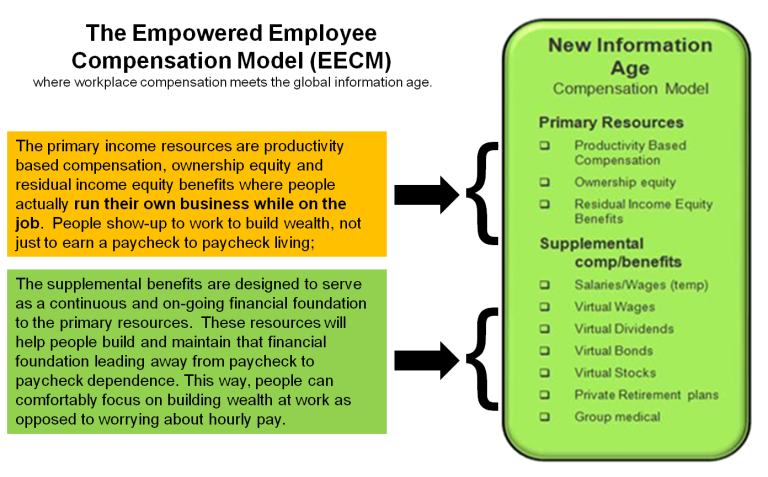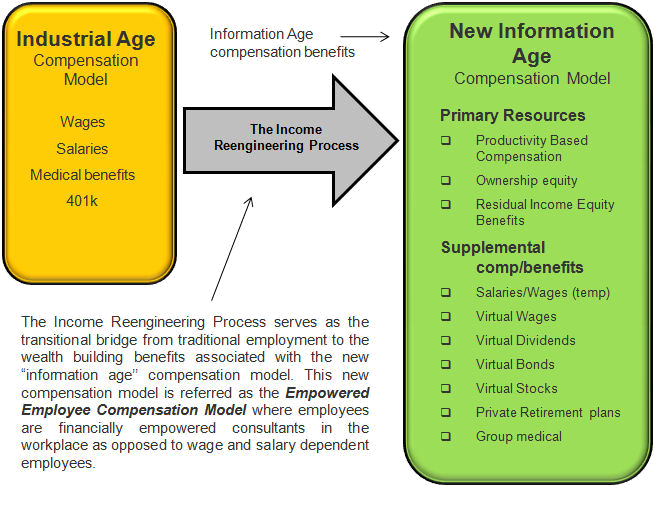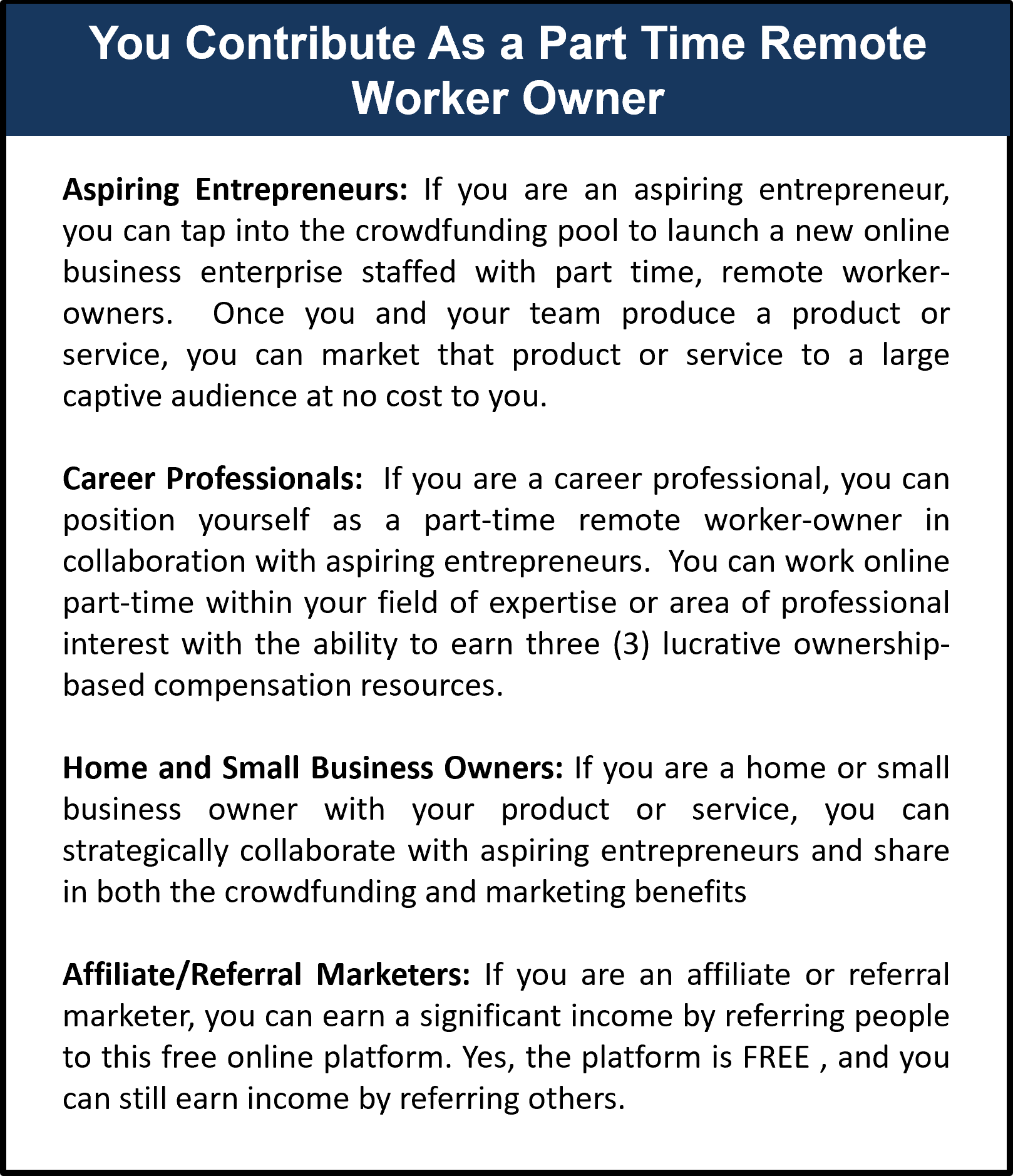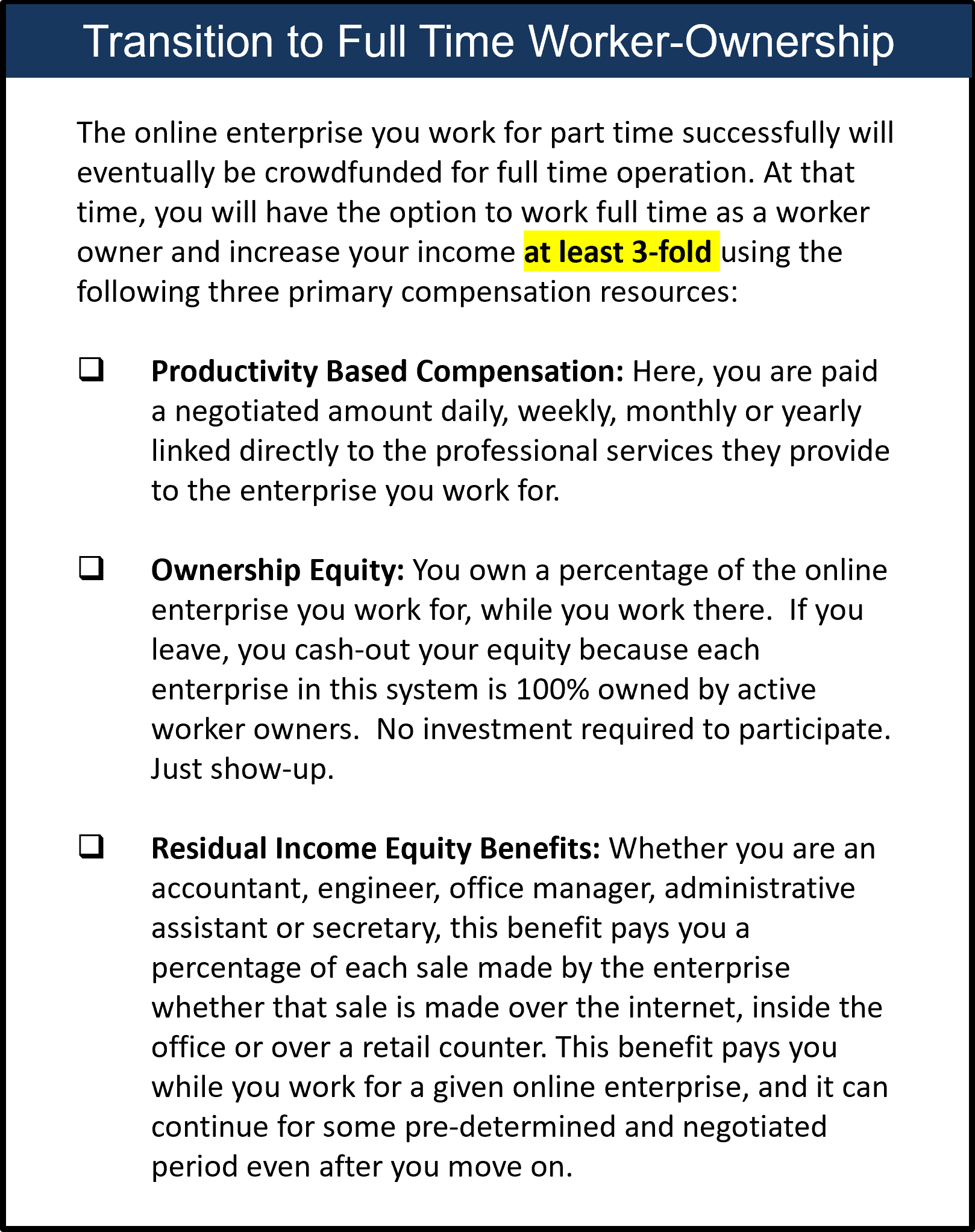The Economic Research
This is a comprehensive economic research campaign that offers significant part time income production opportunities to individuals, entrepreneurs, freelancers and consultants willing to learn, engage and contribution professionally. Below is a snapshot of key concepts and operational models:
Core Mission/Concepts
Here's an outline of the core mission and associated concepts:
- Given the issues of income inequality and the rising gap between rich and poor, it’s time for aggressive new thinking on how we can apply grassroots-led solutions to address and solve this issue, as opposed to always relying on the government;
- To this end, our operational mission is to conduct grassroots-led economic research into how to apply the internet and other information technology to help the masses increase their workplace income at least three times over;
- All research, economic, scientific or otherwise must start with an hypothesis or a guest as to how to address and solve the problem we are looking to solve. Then, we conduct the research necessary to prove or disprove the hypothesis. If the hypothesis prove not to be valid, we create a new hypothesis and start over;
- The hypothesis asssociated with this economic research is that we must install the Empowered Employee Compensation Model (EECM) into the mainstream workplace for the masses to experience at least a 3-fold increase in workplace income;
- The Empowered Employee Compensation Model (EECM) is considered the 21st century version of worker ownership. It replaces hourly wages and salaries with ten (10) new ownership-based income resources and benefits and will usher in 3-fold increase in the aggregate standard of living for the masses;
- For example, Harvard Business School published a research paper regarding how transitional employee-ownership or worker ownership leads to broad based wealth. They found that the average wealth would increase 2 to 4 fold when compared to traditional employment;
- This is amazing. However, this is net or median wealth, primarily driven by the application of an Employee Stock Ownership Plan (ESOP), not income. Our mission statement is to help the masses increase their workplace income at least 3 times over. This said, the Harvard study does illustrate the power and benefits of worker ownership when compared to traditional employment;
- Now, the Harvard report was based on traditional forms of worker ownership: Employee Stock Ownership Plans (ESOPs) and Worker-Owned Cooperatives. However, according to Rutgers University, the first Employee Stock Ownership Plan (ESOP) came into being in 1956, which was 68 years ago. In 68 years, we only see a 0.02% saturation of worker ownership. This is pitiful given the benefits large-scale worker ownership can have on society. Many reasons apply including the complexity of ESOP models and the fact employers are simply uncomfortable with the idea of employees as owners;
- The Empowered Employee Compensation Model (EECM) addresses these problems presented by traditional worker-ownership models because the EECM strategically deploys resources to create an exciting new workplace dynamic that supercharges employee empowerment and employer cash flow flexibility. In other words, WIN-WIN for both employees and employers;
- In fact, the EECM offers significant sales and profit benefits for employers to the point where, according to the hypothesis, most employers will be more than willing to integrate this new compensation model into their workplace once we teach, test and validate model.
Summary of EECM Benefits

Again, the Empowered Employee Compensation Model (EECM) is our starting hypothesis. Here's snapshot of how the EECM will benefit employees, employers, and the nation as a whole:
- Benefits for Employees: Employees can enjoy the advantages of both worlds. They receive income, ownership, profitability, and flexibility typically associated with running a profitable business, all while maintaining the financial security and steady monthly paycheck that a traditional job provides. This financial security and peace of mind come from the supplemental benefits of the model, rather than from hourly wages or salaries. At the core of these supplemental benefits are the Virtual Income Machines, which include virtual wages, virtual dividends, virtual bonds, and virtual stocks. These are blockchain-enabled financial support and wealth-building solutions that form the foundation of the Empowered Employee Compensation Model (EECM);
- Benefits for Employers: Employers benefit from a highly productive workforce, as ownership motivates employees to work efficiently, without the burden of traditional payroll expenses, which typically account for 60% of operating costs. Traditional payroll represents a fixed expense, meaning companies must cover this cost regardless of their monthly sales or profits. The Empowered Employee Compensation Model eliminates this fixed payroll expense by allowing employers to compensate employees based on productivity, sales, or profits. This arrangement provides employers with significantly more cash flow flexibility. Additionally, the supplemental benefits provide employees with the peace of mind of a steady monthly paycheck, reducing the need for employers to pay hourly wages or salaries;
- Benefits for the Nation at Large: The Empowered Employee Compensation Model encourages individuals to take ownership of their productive efforts instead of merely renting their time for an hourly wage. When people own their productivity, they tend to be more efficient. Increased productivity leads to lower costs for producing valuable products and services. As the cost of quality goods and services decreases, individuals can save more money without sacrificing their standard of living. With increased savings, more capital becomes available for business startups and expansions, often at lower interest rates, which generates more job opportunities. With more job options, individuals' skills and experiences become more valuable, resulting in higher incomes.
You can learn more about the EECM here.
General Operations

Don Tapscott, in his book Wikinomics, famously stated, "Mass Collaboration Changes Everything." In this context, the phrase mass collaboration refers to large-scale, grassroots-led, internet-centered collaboration. Therefore our objective is to harness the power of large, grassroots-led, internet-centered mass collaboration and put it into action toward achieving our mission of putting the Empowered Employee Compensation Model to the test.
To do it, we will adopt the following operational focus: utilize the economic power of this mass collaboration to motivate, create, staff, and crowdfund the formation of thousands of new companies organized under the Empowered Employee Compensation Model (EECM). We refer to these new ventures as EECM Enterprises.
Think of it as a virtual corporation, employing thousands of part-time independent contractors, freelancers, consultants, and entrepreneurs who collaborate and interact online, functioning as a unified organization. The top-level mission of this organization is to motivate, create, staff, and crowdfund the formation of thousands of new companies organized under the Empowered Employee Compensation Model (EECM). Once operational, these new EECM enterprises produce new products and services that are marketed and promoted by this new virtual corporation.
This comes alive via the Steps 1 thru Step 6 below. Note: Step 1 thru 6 below is formally called the Income Reengineering Process as illustrated in the diagram above:
- Step 1: We launch an online platform to facilitate this large-scale, mass collaboration;
- Step 2: We then encourage grassroots individuals from all walks of life and professional disciplines to come online part-time, learn the mission, learn the proposed workplace compensation models, get their questions answered, and buy into the mission. This buy-in is crucial to running and crowdfunding operations;
- Step 3: Upon achieving buy-in, people decide how they want to participate in and/or support the mission. Many who buy into the mission initially may prefer to observe from the sidelines, support operations through crowdfunding, and, when comfortable, participate professionally. On the other hand, others may choose to take the lead as early collaborators in forming EECM Enterprises. These are primarily aspiring entrepreneurs incentivized with crowdfunding dollars and will have the opportunity to market and promote their products and services to a large audience comprised of mission supporters;
- Step 4: Once crowdfunded, aspiring entrepreneurs will staff their EECM enterprises with other mission supporters. All staff members of these EECM Enterprises can earn significant income part-time as worker-owners working remotely;
- Step 5: Over time, successful EECM enterprises can secure crowdfunding to advance to full-time status and transition their part-time staff to full-time employment as worker-owners or at least those who choose to make the transition. Conceptually, each full worker owner will be in a position to maximize the primary resources of the EECM (i.e, productivity-based compensation, ownership equity, and the residual income equity benefit) and increase their professional income at least 3 times over;
- Step 6: Continuous growth and expansion of Steps 1 through 5 will reinforce the validity of the EECM and associated operations, eventually creating thousands upon thousands of full-time EECM Enterprises where worker-owners earn three times more than they would in traditional companies. As this continues, traditional companies will find it hard to find qualified workers willing to work for a mere wage or salary. This will lead to a natural, economically driven tradition to the Empowered Employee Compensation Model as the primary form of compensation paid to workers.
Over time, Steps 1 through 6 will evolve into a massive test bed of peer-to-peer collaboration and co-creation activities that we must track, evaluate, and adjust as needed to move operations forward, which is the essence of this economic research activity.
Business Plan and Crowdfunding Framework
This economic research campaign grows and expands according to a four-stage business plan:

As you can see, we support each stage with a unique crowdfunding solution required to stimulate and motivate the grassroots sector to support this economic research initiative. These new crowdfunding models are required because we can not rely on any traditional crowdfunding or fundraising solution to fund the new EECM Enterprises.
Income Production Opportunities
You have a unique opportunity to contribute significantly to this research from the beginning. You don’t need to be a rocket scientist; simply be willing to engage part-time online and apply your skills in your area of expertise or professional interest. Below, you’ll find several storyboards that tell the story of the part-time and full-time income production and wealth-building opportunities available to you.


As you can see, you can earn income and build wealth limited only by your attention to detail and the value of your professional contribution to online enterprise your work.
How to Get Started
Your next step is to visit the M.I.N.D.S. educational hub and learn more.
|Home|About Us|Research|Hub|Support Research|Contact
